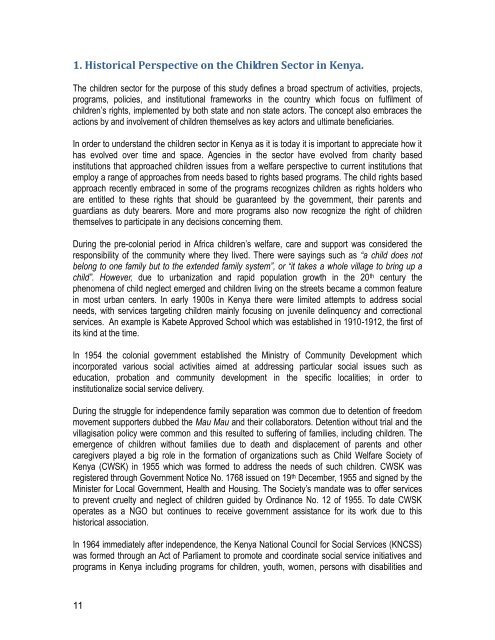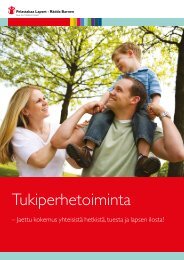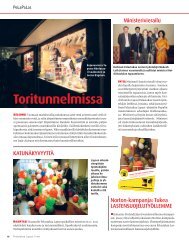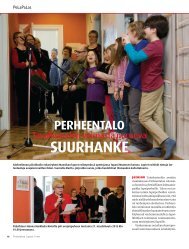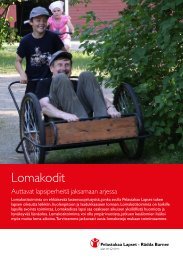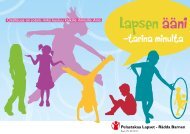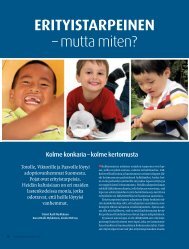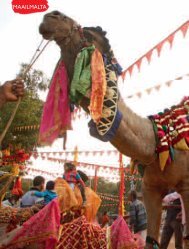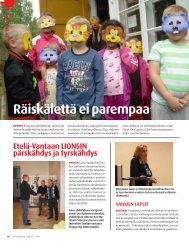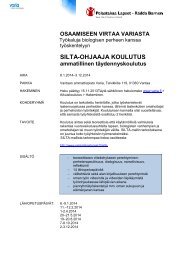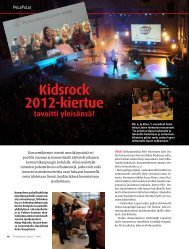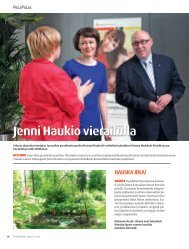Promoting child rights in Kenya - Pelastakaa Lapset ry
Promoting child rights in Kenya - Pelastakaa Lapset ry
Promoting child rights in Kenya - Pelastakaa Lapset ry
Create successful ePaper yourself
Turn your PDF publications into a flip-book with our unique Google optimized e-Paper software.
1. Historical Perspective on the Children Sector <strong>in</strong> <strong>Kenya</strong>.The <strong>child</strong>ren sector for the purpose of this study def<strong>in</strong>es a broad spectrum of activities, projects,programs, policies, and <strong>in</strong>stitutional frameworks <strong>in</strong> the count<strong>ry</strong> which focus on fulfilment of<strong>child</strong>ren’s <strong>rights</strong>, implemented by both state and non state actors. The concept also embraces theactions by and <strong>in</strong>volvement of <strong>child</strong>ren themselves as key actors and ultimate beneficiaries.In order to understand the <strong>child</strong>ren sector <strong>in</strong> <strong>Kenya</strong> as it is today it is important to appreciate how ithas evolved over time and space. Agencies <strong>in</strong> the sector have evolved from charity based<strong>in</strong>stitutions that approached <strong>child</strong>ren issues from a welfare perspective to current <strong>in</strong>stitutions thatemploy a range of approaches from needs based to <strong>rights</strong> based programs. The <strong>child</strong> <strong>rights</strong> basedapproach recently embraced <strong>in</strong> some of the programs recognizes <strong>child</strong>ren as <strong>rights</strong> holders whoare entitled to these <strong>rights</strong> that should be guaranteed by the government, their parents andguardians as duty bearers. More and more programs also now recognize the right of <strong>child</strong>renthemselves to participate <strong>in</strong> any decisions concern<strong>in</strong>g them.Dur<strong>in</strong>g the pre-colonial period <strong>in</strong> Africa <strong>child</strong>ren’s welfare, care and support was considered theresponsibility of the community where they lived. There were say<strong>in</strong>gs such as “a <strong>child</strong> does notbelong to one family but to the extended family system”, or “it takes a whole village to br<strong>in</strong>g up a<strong>child</strong>”. However, due to urbanization and rapid population growth <strong>in</strong> the 20 th centu<strong>ry</strong> thephenomena of <strong>child</strong> neglect emerged and <strong>child</strong>ren liv<strong>in</strong>g on the streets became a common feature<strong>in</strong> most urban centers. In early 1900s <strong>in</strong> <strong>Kenya</strong> there were limited attempts to address socialneeds, with services target<strong>in</strong>g <strong>child</strong>ren ma<strong>in</strong>ly focus<strong>in</strong>g on juvenile del<strong>in</strong>quency and correctionalservices. An example is Kabete Approved School which was established <strong>in</strong> 1910-1912, the first ofits k<strong>in</strong>d at the time.In 1954 the colonial government established the M<strong>in</strong>ist<strong>ry</strong> of Community Development which<strong>in</strong>corporated various social activities aimed at address<strong>in</strong>g particular social issues such aseducation, probation and community development <strong>in</strong> the specific localities; <strong>in</strong> order to<strong>in</strong>stitutionalize social service delive<strong>ry</strong>.Dur<strong>in</strong>g the struggle for <strong>in</strong>dependence family separation was common due to detention of freedommovement supporters dubbed the Mau Mau and their collaborators. Detention without trial and thevillagisation policy were common and this resulted to suffer<strong>in</strong>g of families, <strong>in</strong>clud<strong>in</strong>g <strong>child</strong>ren. Theemergence of <strong>child</strong>ren without families due to death and displacement of parents and othercaregivers played a big role <strong>in</strong> the formation of organizations such as Child Welfare Society of<strong>Kenya</strong> (CWSK) <strong>in</strong> 1955 which was formed to address the needs of such <strong>child</strong>ren. CWSK wasregistered through Government Notice No. 1768 issued on 19 th December, 1955 and signed by theM<strong>in</strong>ister for Local Government, Health and Hous<strong>in</strong>g. The Society’s mandate was to offer servicesto prevent cruelty and neglect of <strong>child</strong>ren guided by Ord<strong>in</strong>ance No. 12 of 1955. To date CWSKoperates as a NGO but cont<strong>in</strong>ues to receive government assistance for its work due to thishistorical association.In 1964 immediately after <strong>in</strong>dependence, the <strong>Kenya</strong> National Council for Social Services (KNCSS)was formed through an Act of Parliament to promote and coord<strong>in</strong>ate social service <strong>in</strong>itiatives andprograms <strong>in</strong> <strong>Kenya</strong> <strong>in</strong>clud<strong>in</strong>g programs for <strong>child</strong>ren, youth, women, persons with disabilities and11


